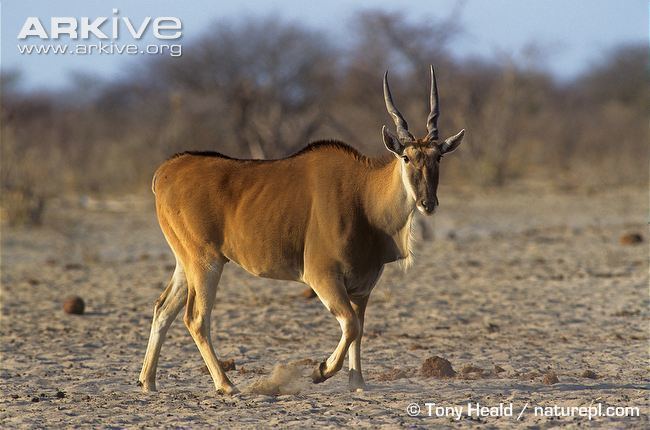Post by dinosauria101 on May 3, 2019 6:31:33 GMT 5
Common Eland - Taurotragus oryx
The common eland (Taurotragus oryx) (Swahili: Mbunga) also known as the southern eland or eland antelope, is a savannah and plains antelope found in East and Southern Africa. It is native to Botswana, Burundi, Congo, Ethiopia, Kenya, Lesotho, Malawi, Mozambique, Namibia, Rwanda, South Africa, South Sudan, Swaziland, Tanzania, Uganda, Zambia and Zimbabwe; and is possibly extinct in Angola. The elands are spiral-horned antelopes belonging to the Bovid tribe of Tragelaphini. An adult male is around 1.6 metres (5 ft) tall at the shoulder (females are 20 centimetres (7.9 in) shorter) and weighs an average of 500–600 kilograms (1,100–1,300 lb, 340–445 kilograms (750–980 lb) for females). It is the second largest antelope in Africa, slightly smaller than the Giant Eland.

Brown Hyenas (clan of 3) - Hyaena brunnea
The brown hyena (Hyaena brunnea, formerly Parahyaena brunnea) is a species of hyena which occurs in Namibia, Botswana, western and southern Zimbabwe, southern Mozambique and South Africa. Brown hyenas can measure 86 to 150 cm (34 to 59 in) in head-and-body length, although they average 110 to 125 cm (43 to 49 in). The height at the shoulder is 71 to 88 cm (28 to 35 in) and the tail is 25 to 35 cm (9.8 to 14 in) long. Unlike the larger spotted hyena, there are no sizable differences between the sexes, though males may be slightly larger than the females. The average adult male weighs 40.2 to 43.7 kg (89 to 96 lb), while the average female weighs 37.7 to 40.2 kg (83 to 89 lb). The normal upper weight limit for the species is 55 kg (120 lb), although an occasional outsized specimen can weigh up to 67.6 to 72.6 kg (149 to 160 lb). Brown hyenas are primarily scavengers, the bulk of their diet consisting of carcasses killed by larger predators, though they may supplement their diet with rodents, insects, eggs and fruit. However, brown hyenas are aggressive scavengers, frequently appropriating the kills of black-backed jackals, cheetahs, and leopards, including adult male leopards.

Credit to Wikipedia
The common eland (Taurotragus oryx) (Swahili: Mbunga) also known as the southern eland or eland antelope, is a savannah and plains antelope found in East and Southern Africa. It is native to Botswana, Burundi, Congo, Ethiopia, Kenya, Lesotho, Malawi, Mozambique, Namibia, Rwanda, South Africa, South Sudan, Swaziland, Tanzania, Uganda, Zambia and Zimbabwe; and is possibly extinct in Angola. The elands are spiral-horned antelopes belonging to the Bovid tribe of Tragelaphini. An adult male is around 1.6 metres (5 ft) tall at the shoulder (females are 20 centimetres (7.9 in) shorter) and weighs an average of 500–600 kilograms (1,100–1,300 lb, 340–445 kilograms (750–980 lb) for females). It is the second largest antelope in Africa, slightly smaller than the Giant Eland.

Brown Hyenas (clan of 3) - Hyaena brunnea
The brown hyena (Hyaena brunnea, formerly Parahyaena brunnea) is a species of hyena which occurs in Namibia, Botswana, western and southern Zimbabwe, southern Mozambique and South Africa. Brown hyenas can measure 86 to 150 cm (34 to 59 in) in head-and-body length, although they average 110 to 125 cm (43 to 49 in). The height at the shoulder is 71 to 88 cm (28 to 35 in) and the tail is 25 to 35 cm (9.8 to 14 in) long. Unlike the larger spotted hyena, there are no sizable differences between the sexes, though males may be slightly larger than the females. The average adult male weighs 40.2 to 43.7 kg (89 to 96 lb), while the average female weighs 37.7 to 40.2 kg (83 to 89 lb). The normal upper weight limit for the species is 55 kg (120 lb), although an occasional outsized specimen can weigh up to 67.6 to 72.6 kg (149 to 160 lb). Brown hyenas are primarily scavengers, the bulk of their diet consisting of carcasses killed by larger predators, though they may supplement their diet with rodents, insects, eggs and fruit. However, brown hyenas are aggressive scavengers, frequently appropriating the kills of black-backed jackals, cheetahs, and leopards, including adult male leopards.
Credit to Wikipedia


